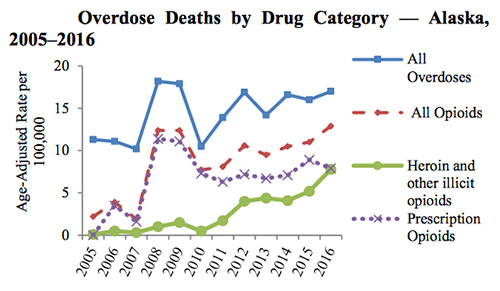
Fentanyl found in three individuals who died from overdoses
May 21, 2017
The Alaska state medical examiner has confirmed that three individuals who recently died of overdose in Anchorage have tested positive for fentanyl and other substances including heroin and morphine. Fentanyl is much more potent than heroin and morphine, and is sometimes added to these drugs by dealers to increase the high. There is no way for a user to determine if fentanyl or similar compounds are present in the drug they are taking without a laboratory test, thus raising the risk of a fatal overdose.
There has been a recent spike in heroin-related emergency department visits in late April and into May. Toxicology tests for eight other suspected overdose deaths since late April are pending. Most deaths were in Anchorage. Clusters of overdoses related to fentanyl happened in Alaska last year. The total number of opioid deaths in Alaska that involved fentanyl or another synthetic opioid other than methadone in 2014, 2015 and 2016 was 41. Over the three years, 27 were linked specifically to fentanyl. Driven primarily by heroin and other illicit drugs, Alaska’s drug overdose death rate increased in 2016. Notable demographic changes in 2016 included higher death rates among a younger age-group (25–34 year-olds) and among Gulf Coast residents. The rate of overdose deaths has steadily increased in Alaska and nationally due to three sequential epidemiological phenomena, according to the Alaska Health & Social Services Epidemiology department. The first began in the mid-1990s with changes in standards for pain management, approval of new, extended release prescription opioid pain relievers, and aggressive pharmaceutical marketing to encourage the use of prescription opioids. A four-fold increase in prescribing led to a roughly four-fold increase in prescription opioid deaths and created a widespread increase in opioid dependency and addiction. The second wave emerged over the last 10–15 years as heroin prices decreased, and the purity increased, offering an alternative to prescription opioids for persons who were addicted to or dependent on opioids. The third wave developed over the past 3 years as illicit fentanyl began to enter the opioid black market. Subsequent to Governor Bill Walker’s declaration of the opioid epidemic as a public health disaster in February 2017, Alaska Project HOPE (Harm reduction, Overdose Prevention, and Education) has been providing overdose reversal kits with prepackaged naloxone nasal spray (4mg/0.1mg dose) to overdose prevention programs under a statewide standing order. Project Hope is one of several initiatives the state has undertaken to address Alaska’s ongoing opioid epidemic. The Alaska Department of Health and Social Services urges users, their family and friends to obtain free naloxone (Narcan) overdose-reversal kits. More than one dose of Narcan may be needed to reverse an overdose. According to the Alaska Department of Health and Social Services, people who regularly come in contact with potential users may also want to have kits on hand. Call 911 immediately after administering Narcan and be ready to do CPR until emergency responders arrive. The state is distributing the free Narcan kits through Project Hope partners statewide. For a map of distributing agencies, visit www.opioids.alaska.gov and www.heroin.alaska.gov. In keeping with national guidelines, prevention measures to control the opioid epidemic in Alaska include improving clinical pain management strategies, reducing prescription drug misuse, facilitating drug disposal, and controlling illicit drug importation into Alaska.
On the Web:
Editing by Mary Kauffman, SitNews
Source of News:
Representations of fact and opinions in comments posted are solely those of the individual posters and do not represent the opinions of Sitnews.
|
|||
